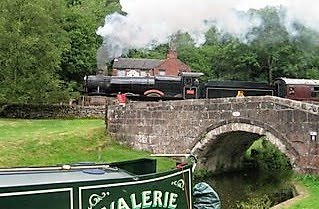I remember first cruising through Leighton Buzzard some 8 years ago and wondering what these raised banks were used for. I of course guessed they were for loading something onto a
boat but had no idea what. At some point in time I discovered the answer having noticed the rails on one of the wharves. It`s all to do with sand. Not just the normal stuff but Silica rich sand famous for it`s quality all over the world.
There are three of these wharves, this one is the first as you boat into L.Buzzard heading north and was joined to Arnolds Rackley sand pit.
Garside and Arnold were the dominant names in sand at L.Buzzard.
Arnolds had six horse drawn boats but gave up using boats in the 1930`s. Garside also had boats and in 1912 shipped 500 boatloads and still used the canal into the 1950`s. George Garside started his sand business in the 1890`s. Every Easter his wife would travel on one of the company boats to Paddington basin and distribute Easter eggs and oranges to the boat children.
 Horses and carts plus steam lorries were the main transport for the sand from pits north of the town to transport sites be they rail or water in the south. The town centre was the main route and so much damage was caused to the roads that in 1919 the narrow gauge railway was created using a 2 foot gauge. Garside and Arnold set up the company called the Leighton buzzard light railway. At certain places the rails crossed the roads and today they still do but as a tourist attraction. In the 1960`s a group of enthusiasts took over a section and run passenger trips.
Horses and carts plus steam lorries were the main transport for the sand from pits north of the town to transport sites be they rail or water in the south. The town centre was the main route and so much damage was caused to the roads that in 1919 the narrow gauge railway was created using a 2 foot gauge. Garside and Arnold set up the company called the Leighton buzzard light railway. At certain places the rails crossed the roads and today they still do but as a tourist attraction. In the 1960`s a group of enthusiasts took over a section and run passenger trips. 
On the map above;
 A is Tesco`s
A is Tesco`sB is the loading wharf very top of page.
C is Brantoms wharf (features next blog post)
D is Grove lock.
E is the old railway branch to Dunstable.
F is bridge 110 (sand `ole) pictured in my last post. Arnolds boats loaded here from their pits at Heath and Reach.
On the right is one of the trains working in a sand pit.
Nowadays although the sand industry still exists signs of the pits has all but disappeared with some having been filled many years back with rubbish from London and now industrial estates cover the sites. Tiddenfoot Lake was once a sand pit but is now a waterside park on the left as you enter L. Buzzard on the canal.
One hundred and fifty years on and sand still leaves L. Buzzard but road transport has now taken the place of rail and water.
Some links here and here and here and here





2 comments:
Hi Les, This is interesting to me as I had an aunt who lived in Soulbury and who caught the train to London each day for work till she retired. I remember once when staying with her, driving to catch the train into London and getting lost - instead of heading for BR I ended up aiming for the light rail tourist one! My aunt was more interested in Richard III than the history of Leighton Buzzard, so I didn't know about the sand pits. Our love of the canals started at Soulbury as we did our first narrowboat holiday with Wyvern Shipping at Linslade in 1990 - now, 24 years later, we will be starting our own liveaboard adventure in May!
Glad to see photos of you wielding the axe - looking good! Long may it continue! Marilyn McD
Hi Marilyn
When you cruise past Wyvern shipping the memories will flood back. This time of year when all the boats are moored up 3/4 abreast getting past can be interesting or at least it can be when a boat comes the other way on the bend.
Picture on link below.
http://boatlife.blogspot.co.uk/2013/02/water-where-it-should-not-be.html
Les
Post a Comment